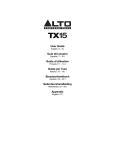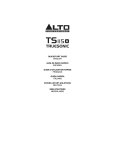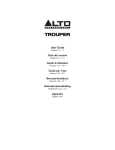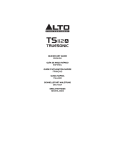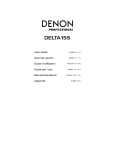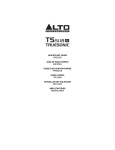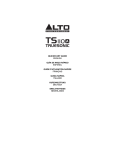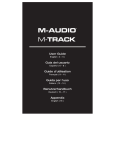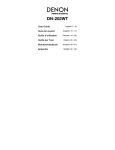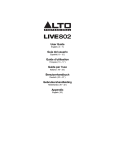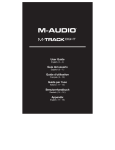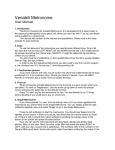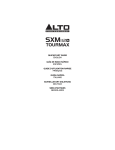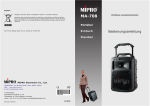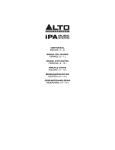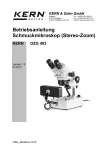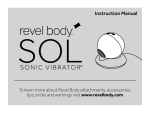Download TX10 User Guide - Alto Professional
Transcript
User Guide English ( 3 – 6 ) Guía del usuario Español ( 7 – 10 ) Guide d'utilisation Français ( 11 – 14 ) Guida per l'uso Italiano ( 15 – 18 ) Benutzerhandbuch Deutsch ( 19 – 22 ) Gebruikershandleiding Nederlands ( 23 – 26 ) Appendix English ( 27 ) User Guide (English) Introduction Box Contents TX10 User Guide Power Cable Safety & Warranty Manual Support For the latest information about this product (system requirements, compatibility information, etc.) and product registration, visit altoprofessional.com/tx10. For additional product support, visit altoprofessional.com/support. Important Safety Precautions Please note: Alto Professional and inMusic are not responsible for the use of its products or the misuse of this information for any purpose. Alto Professional and inMusic are not responsible for the misuse of its products caused by avoiding compliance with inspection and maintenance procedures. Please also refer to the included safety and warranty manual for more information. Important: Do not suspend a TX Series loudspeaker. It is not designed for suspended applications. We recommend our Truesonic Series or Black Series loudspeakers for suspended applications instead. Stand-Mounting • Always install loudspeakers in accordance with applicable electrical and building codes. • Install the loudspeaker according to its maximum weight. Check the specifications of your stand or pole to ensure it can support the loudspeaker's weight. Also, observe all safety precautions specified by the manufacturer. • Do not mount multiple loudspeakers on the same stand or pole. • Always verify that the stand or pole is on a flat, level, and stable surface. Also, fully extend the legs of tripod-style stands, and ensure its legs do not present a trip hazard. • Inspect the stand (or pole and associated hardware) before each use and do not use equipment with worn, damaged, or missing parts. • Always be cautious in windy, outdoor conditions. You may need to place additional weight (e.g., sandbags) on stand's base to improve stability. Do not attach banners or similar items to any part of a loudspeaker system. Such attachments could act as a sail and topple the system. • Unless you are confident that you can handle the loudspeaker's weight, ask another person to help you lift it onto the stand or pole. • Make sure your cables are out of the way of performers, production crew, and audience so they will not trip over them, pulling the loudspeaker off the stand or pole. 3 Sound Level Permanent hearing loss may be caused by exposure to extremely high noise levels. The U.S. Occupational Safety and Health Administration (OSHA) has specified permissible exposures to certain noise levels. According to OSHA, exposure to high sound pressure levels (SPL) in excess of these limits may result in hearing loss. When using equipment capable of generating high SPL, use hearing protection while such equipment is under operation. Hours per day 8 6 4 3 2 SPL (dB) 90 92 95 97 100 Example Small gig Train Subway train High level desktop monitors Classical music concert Hours per day 1.5 1 .50 .25 or less SPL (dB) Example 102 Riveting machine 105 Machine factory 110 Airport 115 Rock concert Wire Connections You can wire your XLR or 1/4" TRS cables as balanced or unbalanced. Here are some examples: (Pin2) (Pin2) (Pin3) Tip Sleeve Ring Tip Sleeve Ring Tip Sleeve (Pin3) (Pin1, linked to Pin3) (Pin1) Determine the wiring configuration you need for your application and audio connections: 3 3 2 2 1 1 Balanced 1 3 2 Unbalanced 1 3 2 Tip Ring Sleeve 1 2 3 1 2 3 Tip Ring Sleeve Tip 1 2 3 1 2 3 Center 1 Tip Ring Sleeve 1 2 3 Tip Ring Sleeve 3 2 3 3 1 2 3 1 1 2 3 1 2 2 Sleeve 4 Screen Tip Sleeve Tip Sleeve Tip Ring Sleeve Tip Ring Sleeve Tip Sleeve Center Screen Tip Ring Sleeve Center 1 2 3 Screen 1 2 3 Quick Start / Connection Diagrams Note: Items not listed in the Box Contents are sold separately. Example A: 2 loudspeakers Connect each of your mixer's main outputs to the Input on a TX loudspeaker. Microphones (mixer's main outputs) Power Power Mixer Example B: 2 loudspeakers, 2 extensions Connect each of your mixer's main outputs to the Input on a TX loudspeaker. Connect each of your TX loudspeakers' Link Outputs to the inputs of your extension loudspeakers. Microphones (mixer's main outputs) Power Power Mixer 5 Features Rear Panel 6 7 8 5 3 4 4 2 1 1. AC Input: Use the included power cable to connect this input to a power outlet. Make sure the Power Switch is set to off when connecting or disconnecting the cable. 2. Power Switch: Use this switch to power the loudspeaker on or off. Make sure the Volume knob is set to its minimum (counterclockwise) position before turning it on. 3. Power LED: This LED lights up when the loudspeaker is on. 4. Cooling Vent: Keep the area in front of this vent clear from obstructions. The fan behind the vent cools the amplifier, preventing overheating. 5. Volume: Turn this knob to adjust the loudspeaker's volume. 6. Input: Use a standard XLR cable (not included) to connect your audio source to this input. Make sure to set the Volume knob to the correct position. 7. Link Output: Use a standard XLR cable (not included) to connect this output to the input of another loudspeaker (i.e., another TX loudspeaker). 8. Signal Limit LED: This LED lights up when the audio signal being sent to the loudspeaker is "clipping" or distorting. If this LED illuminates frequently or steadily, reduce the volume of your audio source. 6 Guía del usuario (Español) Introducción Contenido de la caja TX10 Guía del usuario Cable de alimentación Manual sobre la seguridad y garantía Soporte Para obtener la información más completa acerca de este product (los requisitos del sistema, compatibilidad, etc) y registro del producto, visite altoprofessional.com/tx10. Para soporte adicional del producto, visite altoprofessional.com/support. Precauciones importantes para la seguridad Para tener en cuenta: Alto Professional e inMusic no son responsables del uso de sus productos o el mal uso de esta información para cualquier propósito. Alto Professional e inMusic no son responsables del mal uso de sus productos causados por la omisión del cumplimiento de los procedimientos de inspección y mantenimiento. Para más información, consulte también el manual de seguridad y garantía incluido. Importante: No suspenda los altavoces TX Series. No se diseñaron para funcionar suspendidos. Recomendamos los altavoces Truesonic Series o Black Series para ese propósito. Montaje en soporte • Instale siempre los altavoces de acuerdo con los códigos de electricidad y construcción aplicables. • Instale el altavoz de acuerdo a su peso máximo. Compruebe las especificaciones de su soporte o columna para asegurarse de que pueda soportar el peso del altavoz. Asimismo, observe todas las precauciones para la seguridad especificadas por el fabricante. • No monte varios altavoces en el mismo soporte o columna. • Verifique siempre que el soporte o columna esté sobre una superficie plana, nivelada y estable. Asimismo, extienda totalmente las patas de los soportes tipo trípode y asegúrese de que las patas no representen un riesgo de tropiezo. • Inspeccione el soporte (o columna y elementos de fijación asociados) antes de cada uso y no utilice equipos con piezas desgastadas, dañadas o faltantes. • Tenga siempre cuidado en condiciones de viento a la intemperie. Es posible que deba colocar peso adicional (como bolsas de arena) en la base del soporte para mejorar la estabilidad. No fije pancartas o elementos similares a ninguna parte del sistema de altavoces. Tales agregados pueden funcionar como velas y hacer volcar el sistema. • Salvo que tenga confianza de que puede manejar el peso del altavoz, solicite a otra persona que le ayude a levantarlo para colocarlo en el soporte o columna. • Asegúrese de que los cables estén fuera del camino de los intérpretes, personal de producción y audiencia, de modo que no tropiecen con ellos y hagan caer el altavoz del soporte o columna. 7 Nivel de sonido La exposición a niveles muy altos de ruido puede causar pérdidas auditivas permanentes. La Administración de Seguridad y Salud Ocupacional de EE.UU. (OSHA) ha especificado los niveles de exposición permisibles a ciertos niveles de ruido. Según la OSHA, la exposición a niveles de presión sonora (SPL) elevados que excedan estos límites puede causar pérdidas auditivas. Cuando utilice equipos capaces de generar SPL elevados, use protecciones auditivas mientras dichos equipos están en funcionamiento. Horas diarias 8 6 4 3 2 SPL (dB) 90 92 95 97 100 Horas diarias 1,5 1 0,50 0,25 o menos Ejemplo Música de bajo volumen Tren Tren subterráneo Monitores de escritorio de alto nivel Concierto de música clásica SPL (dB) 102 105 110 115 Ejemplo Remachadora Máquina fabril Aeropuerto Concierto de rock Cableado Puede cablear sus cables XLR o TRS de 1/4 pulg. como balanceados o no balanceados. Aquí hay algunos ejemplos: (Patilla 2) (Patilla 3) Punta Nuca Manguito Punta Manguito Nuca Punta Manguito (Patilla 2) (Patilla 1, unida a Patilla 3) (Patilla 3) (Patilla 1) Determine la configuración del cableado necesario para su aplicación y conexiones de audio: 3 3 2 2 1 1 Balanceado 1 3 2 No balanceado 1 3 2 1 Punta Nuca Manguito 1 2 3 1 2 3 Punta Nuca Manguito Punta 1 2 3 1 2 3 Centro 3 Punta Nuca Manguito 1 2 3 Punta Nuca Manguito 2 3 3 1 2 3 1 1 2 3 1 2 2 Manguito 8 Anillo Punta Manguito Punta Manguito Punta Nuca Manguito Punta Nuca Manguito Punta Manguito Centro Anillo Punta Nuca Manguito 1 2 3 Centro Anillo 1 2 3 Diagrama de inicio / conexión rápida Nota: Los elementos que no se enumeran en Contenido de la caja se venden por separado. Ejemplo A: 2 altavoces Conecte cada una de las salidas principales de su mezclador a una entrada de un altavoz TX. Micrófonos (salidas principals del mezclador) Suministro eléctrico Suministro eléctrico Mezclador Ejemplo B: 2 altavoces, 2 extensiones Conecte cada una de las salidas principales de su mezclador a una entrada de un altavoz TX. Conecte cada una de las salidas Link (Salida de la mezcla) de sus altavoces TX a las entradas de sus altavoces de extensión. Micrófonos (salidas principals del mezclador) Suministro eléctrico Suministro eléctrico Mezclador 9 Características Panel trasero 6 7 8 5 3 4 4 2 1. Entrada de corriente alterna: Utilice el cable de corriente incluido para conectar esta entrada a una toma de corriente. Asegúrese de que el interruptor Power (Encendido) esté en la posición off (apagado) cuando conecte o desconecte el cable. 2. Interruptor de encendido: Use este interruptor para encender y apagar el altavoz. Asegúrese de que la perilla Volume esté en su posición mínima (antihoraria) antes de encenderlo. 3. LED de encendido: Este LED se ilumina cuando el altavoz está encendido. 4. Respiraderos de enfriamiento: Mantenga el área frente a esta ventilación libre de obstáculos. El ventilador que está detrás de la ventilación enfría el amplificador, evitando el recalentamiento. 5. Volumen: Gire esta perilla para ajustar el volumen del altavoz. 6. Entrada: Use un cable XLR estándar (no incluido) para conectar su fuente de audio a esta entrada. Asegúrese de colocar la perilla Volume en la posición correcta. 7. Salida Link: Utilice un cable XLR estándar (no incluido) para conectar esta salida a la entrada de otro altavoz (por ej. otro altavoz TX). 8. LED de límite de señal: Este LED se enciende cuando la señal de audio que se envía al altavoz se "recorta" o distorsiona. Si este LED se enciende con frecuencia o en forma permanente, reduzca el volumen de su fuente de sonido. 1 10 Guide d'utilisation (Français) Introduction Contenu de la boîte TX10 Guide d'utilisation Câble d'alimentation Consignes de sécurité et informations concernant la garantie Assistance Pour les dernières informations concernant ce produit (la configuration système minimale requise, la compatibilité, etc) et l’enregistrement du produit, veuillez visitez le site altoprofessional.com/tx10. Pour de plus amples informations, visitez altoprofessional.com/support. Consignes de sécurité importantes Veuillez noter : Alto Professional et inMusic ne sont pas responsables de la mauvaise utilisation de leurs produits ou de l'utilisation faite de ces informations. Alto Professional et inMusic ne sont pas responsables de la mauvaise utilisation de leurs produits causés par le non-respect des procédures d'entretien et d'inspection. Veuillez également consulter le guide des consignes de sécurité et informations concernant la garantie inclus. Important : Ne pas suspendre les enceintes de la série TX. Elles ne sont pas conçues afin d'être suspendues. Nous recommandons plutôt d'utiliser nos enceintes des séries Truesonic ou Black pour les applications suspendues. Montage sur support • Toujours installer des haut-parleurs conformément aux codes de l'électricité et du bâtiment en vigueur. • Installer le haut-parleur en tenant compte de son poids maximal. Vérifier les spécifications du support ou du pied pour faire en sorte qu'il peut supporter le poids du haut-parleur. Observer toutes les consignes de sécurité spécifiées par le fabricant. • Ne pas monter plusieurs haut-parleurs sur le même support ou le même pied. • Toujours vérifier que le support ou le pied est sur une surface plane, stable et au niveau. Déployer entièrement les pieds des supports de style trépied et vérifier qu'ils ne présentent pas un risque de trébuchement. • Vérifier le support (ou pied et la quincaillerie) avant chaque utilisation et ne pas utiliser de l'équipement avec des pièces usées, endommagées ou manquantes. • Faire preuve de prudence lorsqu'utilisé à l'extérieur dans des conditions venteuses. Il peut être nécessaire de placer un poids supplémentaire (p. ex., des sacs de sable) sur la base du support afin d'améliorer sa stabilité. Ne pas fixer de bannières ou autres objets similaires au système de haut-parleur. Ces objets pourraient prendre dans le vent et renverser le système. • À moins d'être certain de pouvoir gérer le poids du haut-parleur, demander à une autre personne de vous aider afin de le placer sur le support ou le pied. • Toujours s'assurer que les câbles sont tenus éloignés des artistes, de l'équipe de production et du public afin qu'ils ne puissent trébucher sur le câble et faire tomber le haut-parleur de son support. 11 Niveau sonore L'exposition aux niveaux extrêmement élevés de bruit peut causer une perte d'audition permanente. Le comité de santé et de sécurité au travail des États-Unis (OSHA) a établi des durées d'exposition acceptables pour certains niveaux de bruit. Selon la OSHA, une exposition à des niveaux de pression acoustique (NPA) au-dessus de ces limites peut avoir comme conséquence une perte d'audition. Lors de l'utilisation d'équipement capable de générer des niveaux de pression acoustique élevés, il faut prendre des mesures afin de protéger son ouïe lorsque cette unité est en fonction. Heures par jour 8 6 4 3 2 NPA (dB) 90 92 95 97 100 Exemple Petite salle de spectacle Train Rame de métro Moniteurs de table à niveaux élevés Concert de musique classique Heures par jour 1,5 1 0,50 moins de 0,25 NPA (dB) 102 105 110 115 Exemple Riveteuse Usine de fabrication Aéroport Concert rock Connectiques Vous pouvez brancher vos câbles XLR ou TRS 6,35 mm (¼ po) de manière symétrique ou asymétrique. Voici quelques exemples : (Broche2) (Broche2) (Broche3) Pointe Corps Bague Pointe Corps Bague Pointe Corps (Broche3) (Broche1, connectée à la broche3) (Broche1) Déterminez la configuration de câblage dont vous avez besoin selon votre application et connexions audio : 3 3 2 2 1 1 Symétrique 1 3 2 Asymétrique 1 3 2 1 Pointe Bague Corps 1 2 3 1 2 3 Pointe Bague Corps Pointe 1 2 3 1 2 3 Centre 3 Pointe Bague Corps 1 2 3 Pointe Bague Corps 2 3 3 1 2 3 1 1 2 3 1 2 2 Corps 12 Anneau Pointe Corps Pointe Corps Pointe Bague Corps Pointe Bague Corps Pointe Corps Centre Anneau Pointe Bague Corps 1 2 3 Centre Anneau 1 2 3 Démarrage rapide/Schéma de connexion Remarque : Les éléments qui ne figurent pas dans l’encadré Contenu de la boîte sont vendus séparément. Exemple A : 2 enceintes Branchez les sorties principales de votre console de mixage aux entrées (Input) des enceintes TX. Microphones (sorties principales de la console de mixage) Alimentation Alimentation Console de mixage Exemple B : 2 enceintes, 2 enceintes d’extension Branchez les sorties principales de votre console de mixage aux entrées (Input) des enceintes TX. Branchez les sorties Link de vos enceintes TX aux entrées de vos enceintes d'extension. Microphones (sorties principales de la console de mixage) Alimentation Alimentation Console de mixage 13 Caractéristiques Panneau arrière 6 7 8 5 3 4 4 2 1 1. Entrée d'alimentation CA : Utilisez le câble d’alimentation inclus pour brancher cette entrée à une prise secteur. Veuillez vous assurer que l’interrupteur d’alimentation soit réglé sur « Off » lorsque vous branchez/débranchez le câble d’alimentation. 2. Interrupteur d'alimentation : Utilisez cet interrupteur pour mettre l’enceinte sous et hors tension. Assurez-vous que le bouton du volume soit au minimum (sens horaire) avant de mettre l’enceinte sous tension. 3. Témoin d'alimentation DEL : Ce témoin s’allume lorsque l’enceinte est sous tension. 4. Orifice de ventilation : Veuillez vous assurer de maintenir cet orifice non obstrué en tout temps. Le ventilateur se trouvant derrière permet de refroidir l’amplificateur afin qu’il ne surchauffe pas. 5. Volume : Ce bouton permet d’ajuster le volume de l’enceinte. 6. Entrée : Utilisez un câble XLR (non inclus) standard pour brancher une source audio à cette entrée. Veuillez vous assurer que le bouton volume soit réglé sur la bonne position. 7. Sortie Link : Utilisez un câble XLR standard (non inclus) pour relier cette sortie à l'entrée d'une autre enceinte (p. ex., une autre enceinte TX). 8. Témoin d’écrêtement DEL : Ce témoin s’allume lorsque le signal audio envoyé à l’enceinte est déformé (écrêtage). Si le témoin clignote ou s’allume de façon constante, diminuez le volume de la source audio. 14 Guida per l'uso (Italiano) Introduzione Contenuti della confezione TX10 Guida per l'uso Cavo di alimentazione Istruzioni di sicurezza e garanzia Assistenza Per conoscere le ultime informazioni in merito a questo prodotto (i requisiti di sistema complete, compatibilità, ecc) e per la registrazione del prodotto, recarsi alla pagina altoprofessional.com/tx10. Per ulteriore assistenza, recarsi alla pagina altoprofessional.com/support. Importanti precauzioni di sicurezza Nota bene: Alto Professional e inMusic declinano qualsiasi responsabilità per l'uso dei loro prodotti o per l'utilizzo errato delle presenti informazioni a qualsiasi scopo. Alto Professional e inMusic non sono responsabili per il cattivo utilizzo dei loro prodotti causato dalla mancata conformità con le procedure di ispezione e manutenzione. Fare riferimento al manuale di sicurezza e garanzia per maggiori informazioni. Importante: non sospendere gli altoparlanti TX Series. Non sono concepiti per applicazioni sospese. Per applicazioni sospese consigliamo i nostri altoparlanti Truesonic Series o Black Series. Installazione su supporto • A Installare sempre gli altoparlanti in conformità con i codici elettrici ed edilizi in vigore. • Installare gli altoparlanti in base al loro peso massimo. Verificare le specifiche del palco per assicurarsi che sia in grado di sostenere il peso dell'altoparlante. Inoltre, rispettare tutte le indicazioni di sicurezza specificate dal produttore. • Non montare più altoparlanti sullo stesso supporto o palo. • Assicurarsi sempre che il supporto o il palo si trovi su una superficie piana, uniforme e stabile. Inoltre, estendere al massimo le gambe dei supporti a treppiede e assicurarsi che non rappresentino rischio di inciampo. • Ispezionare il supporto (o il palo o la minuteria ad esso associata) prima di ciascun utilizzo e non servirsi dell'apparecchio con parti usurate, danneggiate o mancanti. • Prestare sempre cautela in condizioni ventose all'aperto. Potrebbe essere necessario aggiungere ulteriore peso (ad es. sacchi di sabbia) sulla base del supporto per migliorarne la stabilità. Non fissare striscioni o articoli simili a qualsiasi parte di un sistema di altoparlanti. Questi potrebbero fare da vela e far rovesciare l'impianto. • A meno di non essere sicuri di essere in grado di sostenere il peso dell'altoparlante, chiedere aiuto a un'altra persona per sollevarlo sul supporto o sul palo. • Assicurarsi che i cavi non intralcino gli artisti, lo staff di produzione e il pubblico, in modo che non vi sia il rischio che questi ci inciampino, facendo cadere l'altoparlante dal supporto o dal palo. 15 Livello dell'audio L'esposizione a livelli di rumore estremamente elevati può causare danni permanenti all'udito. L'OSHA americana (Occupational Safety and Health Administration) ha specificato le esposizioni ammissibili a determinati livelli di rumore. Secondo l'OSHA, l'esposizione a elevati livelli di pressione sonora (SPL) in eccesso rispetto ai limiti indicati può causare la perdita dell'udito. Quando si utilizzano attrezzature in grado di generare elevati SPL, servirsi di dispositivi di protezione dell'udito quando tali attrezzature sono in uso. Ore al giorno 8 6 4 3 2 SPL (dB) 90 92 95 97 100 Esempio Piccolo concerto Treno Metropolitana Casse da tavolo ad alto volume Concerto di musica classica Ore al giorno 1,5 1 0,50 0,25 o meno SPL (dB) 102 105 110 115 Esempio Macchina ribaditrice Fabbrica di macchinari Aeroporto Concerto Rock Collegamenti cablati Si possono cablare i fili XLR o TRS da 1/4" come bilanciati o non bilanciati. Ecco alcuni esempi: (Pin2) (Pin2) (Pin3) (Pin3) Punta Anello Manica Punta Manica Anello Punta Manica (Pin1, collegato a Pin3) (Pin1) Stabilire la configurazione di cablaggio necessaria per le proprie applicazioni e i propri collegamenti audio: 3 3 2 2 1 1 Bilanciato 1 3 2 Non bilanciato 1 3 2 1 Punta Anello Manica 1 2 3 1 2 3 Punta Anello Manica Punta 1 2 3 1 2 3 Centro 3 Punta Anello Manica 1 2 3 Punta Anello Manica 2 3 3 1 2 3 1 1 2 3 1 2 2 Manica 16 Anello Punta Manica Punta Manica Punta Anello Manica Punta Anello Manica Punta Manica Centro Anello Punta Anello Manica 1 2 3 Centro Anello 1 2 3 Guida rapida / Schema dei collegamenti Nota bene: elementi non elencati sotto Contenuti della confezione sono venduti separatamente. Esempio A: 2 altoparlanti Collegare ciascuna delle uscite main del mixer all'Ingresso di un altoparlante TX. Microfoni (uscite main del mixer) Alimentazione Alimentazione Mixer Esempio B: 2 altoparlanti, 2 estensioni Collegare ciascuna delle uscite main del mixer all'Ingresso di un altoparlante TX. Collegare ciascuna delle uscite Link degli altoparlanti del TX agli ingressi degli altoparlanti di estensione. Microfoni (uscite main del mixer) Alimentazione Alimentazione Mixer 17 Caratteristiche Pannello posteriore 6 7 8 5 3 4 4 2 1 1. Ingresso CA: servirsi del cavo di alimentazione in dotazione per collegare questo ingresso ad una presa di alimentazione. Assicurarsi che l'interruttore di alimentazione dell'altoparlante sia su "off" al momento di collegare e scollegare il cavo. 2. Interruttore di alimentazione: servirsi di questo interruttore per accendere e spegnere l'altoparlante. Assicurarsi che la manopola Volume sia impostata al minimo (in senso antiorario) prima di accenderlo. 3. LED di alimentazione: si illumina quando l'altoparlante è acceso. 4. Ventola di raffreddamento: mantenere l'area di fronte a questa bocchetta libera da ostacoli. La ventola dietro la bocchetta raffredda l'amplificatore, impedendone il surriscaldamento. 5. Volume: girare questa manopola per regolare il volume dell'altoparlante. 6. Ingresso: servirsi di un cavo standard XLR (non in dotazione) per collegare una fonte audio a questo ingresso. Assicurarsi di posizionare correttamente la manopola Volume. 7. Uscita Link: servirsi di un cavo standard XLR (non in dotazione) per collegare questa uscita all'ingresso di un altro altoparlante (ad es. un altro altoparlante TX). 8. LED limite di segnale: questo LED si accende quando il segnale audio che viene inviato all'altoparlante "salta" o viene distorto. Se questa spia si accende spesso o in maniera fissa, ridurre il volume della fonte audio. 18 Benutzerhandbuch (Deutsch) Einführung Lieferumfang TX10 Benutzerhandbuch Netzkabel Sicherheitshinweise und Garantieinformationen Kundendienst Die neuesten Informationen zu diesem Produkt (Systemanforderungen, Kompatibilitätsinformationen usw.) und die Registrierung Ihres Produkts finden Sie auf altoprofessional.com/tx10. Für zusätzlichen Produkt-Support besuchen Sie altoprofessional.com/support. Wichtige Sicherheitshinweise Bitte beachten Sie: Alto Professional und inMusic sind weder für die Verwendung ihrer Produkte noch für den Missbrauch dieser Informationen für beliebige Zwecke verantwortlich. Alto Professional und inMusic sind nicht für die missbräuchliche Verwendung ihrer Produkte verantwortlich, die durch verabsäumte Inspektions- und Wartungsarbeiten verursacht wurde. Bitte beachten Sie auch das mitgelieferte Handbuch für Sicherheitshinweise und Garantieinformationen. Wichtig: Hängen Sie den TX Series Lautsprecher nicht auf. Er eignet sich nicht für den hängenden Einsatz. Für den hängenden Einsatz empfehlen wir unsere Truesonic Series oder Black Series Lautsprecher. Montage am Ständer • Installieren Sie Lautsprecher stets laut geltenden Elektro- und Bauvorschriften. • Installieren Sie den Lautsprecher in Übereinstimmung mit seinem maximalen Gewicht. Überprüfen Sie die Spezifikationen des Ständers oder des Masts, um sicherzustellen, dass er das Gewicht des Lautsprechers halten kann. Beachten Sie außerdem alle Sicherheitshinweise des Herstellers. • Montieren Sie niemals mehrere Lautsprecher am selben Ständer oder Mast. • Sorgen Sie stets dafür, dass die Ständer oder Maste auf einer flachen, ebenen und stabilen Fläche stehen. Ziehen Sie die Standbeine des stativähnlichen Ständers vollständig heraus und sorgen Sie dafür, dass die Beine keine Stolpergefahr darstellen. • Überprüfen Sie den Ständer (oder Mast samt zugehörigen Komponenten) vor jedem Einsatz und verwenden Sie nie Geräte mit verschlissenen, beschädigten oder fehlenden Teilen. • Lassen Sie bei windigen Verhältnissen im Freien besondere Vorsicht walten. Möglicherweise müssen Sie zusätzliche Gewichte (z.B. Sandsäcke) auf der Ständerbasis platzieren, um die Stabilität zu gewährleisten. Bringen Sie keine Transparente oder ähnliches an irgendwelchen Teilen eines Lautsprechersystems an. Solche Konstruktionen könnten wie ein Segel wirken und das System zu Fall bringen. • Wenn Sie sich nicht sicher sind, ob Sie den Lautsprecher alleine heben können, bitten Sie eine andere Person beim Heben auf einen Ständer/Mast um Hilfe. • Sorgen Sie dafür, dass die Kabel den Künstlern, der Produktions-Crew oder dem Publikum nicht im Weg sind, so dass niemand über Kabel stolpern kann und den Lautsprecher vom Ständer oder Mast reißen kann. 19 Schallpegel Eine Exposition gegenüber extrem hohen Lärmpegeln kann zu bleibenden Hörschäden führen. Die Occupational Safety and Health Administration (OSHA) der US-Regierung hat zulässige Expositionswerte für bestimmte Lärmpegel festgelegt. Laut OSHA können Belastungen durch Schalldruckpegel (SPL), die diese Grenzwerte überschreiten, zu Hörverlust führen. Tragen Sie beim Einsatz von Geräten, die einen hohen Schalldruck erzeugen können, stets einen Gehörschutz. Stunden pro Tag 8 6 4 3 2 SPL (dB) 90 92 95 97 100 Stunden pro Tag 1,5 1 0,50 0,25 oder weniger Beispiel Kleines Konzert Zug U-Bahn Leistungsstarke Desktop-Monitore Konzert mit klassischer Musik SPL (dB) 102 105 110 115 Beispiel Nietmaschine Maschinenfabrik Flughafen Rock-Konzert Kabelverbindungen Sie können Ihr XLR oder 1/4" TRS-Kabel symmetrisch oder unsymmetrisch verdrahten. Hier sind einige Beispiele: (Pin2) (Pin2) (Pin3) (Pin3) Spitze Ring Manschette Spitze Ring Manschette Spitze Manschette (Pin1 mit Pin3 verbunden) (Pin1) Bestimmen Sie die Verdrahtungskonfiguration, die Sie für Ihren Einsatz und Ihre Audio-Verbindungen benötigen: Symmetrisch 3 3 2 2 1 1 Spitze Ring Manschette 1 3 2 Unsymmetrisch 1 2 3 Spitze Ring Manschette 1 3 2 Spitze Ring Manschette 1 Spitze 3 2 3 3 1 2 3 1 1 2 3 1 2 2 Manschette 20 Spitze Ring Manschette 1 2 3 1 2 3 1 2 3 1 2 3 Stift Abschirmung Spitze Manschette Spitze Manschette Spitze Ring Manschette Spitze Ring Manschette Spitze Manschette Stift Abschirmung Spitze Ring Manschette Stift 1 2 3 Abschirmung 1 2 3 Schnellstart / Anschlussdiagramme Hinweis: Teile, die nicht im Lieferumfang angegeben sind, sind separat erhältlich. Beispiel A: 2 Lautsprecher Verbinden Sie jeden Hauptausgang Ihres Mixers mit dem Eingang eines TX Lautsprechers. Mikrofone (Hauptausgänge des Mixers) Stromversorgung Stromversorgung Mixer Beispiel B: 2 Lautsprecher, 2 Erweiterungen Verbinden Sie jeden Hauptausgang Ihres Mixers mit dem Eingang eines TX Lautsprechers. Verbinden Sie alle Link-Ausgänge Ihrer TX Lautsprecher mit den Eingängen Ihrer Erweiterungslautsprecher. Mikrofone (Hauptausgänge des Mixers) Stromversorgung Stromversorgung Mixer 21 Funktionen Rückseite 6 7 8 5 3 4 4 2 1 1. AC-Eingang: Verwenden Sie das mitgelieferte Netzkabel, um diesen Eingang mit einer Steckdose zu verbinden. Sorgen Sie dafür, dass der Netzschalter beim Verbinden oder Trennen des Kabels auf Aus steht. 2. Netzschalter: Verwenden Sie diesen Schalter, um den Lautsprecher ein- oder auszuschalten. Stellen Sie sicher, dass der Lautstärkeregler auf das Minimum eingestellt ist (gegen den Uhrzeigersinn). 3. Power-LED: Diese LED leuchtet auf, wenn der Lautsprecher eingeschaltet ist. 4. Lüftungsöffnung: Der Bereich vor dieser Lüftungsöffnung darf nie blockiert werden. Der Ventilator hinter der Lüftungsöffnung kühlt den Verstärker und verhindert, dass das Gerät überhitzt. 5. Lautstärke: Drehen Sie diesen Knopf, um die Lautstärke des Lautsprechers einzustellen. 6. Eingabe: Verwenden Sie ein handelsübliches XLR-Kabel (nicht im Lieferumfang enthalten), um die Audioquelle an diesen Eingang anzuschließen. Achten Sie darauf, dass sich der Lautstärkeregler in der richtigen Position befindet. 7. Link-Ausgang: Verwenden Sie ein handelsübliches XLR-Kabel (nicht im Lieferumfang enthalten), um diesen Ausgang mit dem Eingang eines weiteren Lautsprechers zu verbinden (z.B. mit einem anderen TX-Lautsprecher). 8. Signal Limit-LED: Diese LED leuchtet, wenn das an den Lautsprecher gesendete Audiosignal "clippt" oder verzerrt. Sollte diese LED häufig oder ständig leuchten, reduzieren Sie die Lautstärke Ihrer Tonquelle. 22 Gebruikershandleiding (Nederlands) Inleiding Inhoud van de doos TX10 Gebruikershandleiding Netsnoer Veiligheidsvoorschriften en handleiding Ondersteuning Voor de laatste informatie over dit product (systeemvereisten, informatie over compatibiliteit, enz.) en productregistratie, bezoek altoprofessional.com/tx10. Voor aanvullende productondersteuning surft u naar altoprofessional.com/support. Belangrijke veiligheidsvoorschriften Opgelet: Alto Professional en inMusic zijn niet verantwoordelijk voor het gebruik van hun producten of het misbruik van deze informatie voor enig doel. Alto Professional en inMusic zijn niet verantwoordelijk voor het misbruik van hun producten dat wordt veroorzaakt door nietnaleving van de inspectie- en onderhoudsprocedures. Raadpleeg voor meer informatie ook de bijgeleverde handleiding veiligheid en garantie. Belangrijk: TX Series luidsprekers niet ophangen. Ze zijn niet ontworpen om te worden opgehangen. Als u de luidsprekers wilt ophangen, dan raden wij u aan de Truesonic Series of Black Series te gebruiken. Op stang monteren • Installeer luidsprekers altijd in overeenstemming met de geldende elektriciteits- en bouwvoorschriften. • Installeer de luidspreker volgens zijn maximale gewicht. Controleer de specificaties van uw statief of stang om ervoor te zorgen dat deze het gewicht van de luidspreker kunnen dragen. Houd alle veiligheidsmaatregelen van de fabrikant in acht. • Hang nooit meerdere speakers op aan een statief of stang. • Controleer altijd of het statief of de stang op een vlakke en stabiele ondergrond staan. Spreid volledig de poten van het statief en zorg ervoor dat er geen risico van struikelen bestaat. • Controleer het statief (of de stang en bijbehorende hardware) voor elk gebruik en gebruik geen apparatuur met versleten, beschadigde of ontbrekende onderdelen. • Wees altijd voorzichtig in winderige buitenomstandigheden. Het kan nodig zijn om extra gewicht (bv. zandzakken) op het voetstuk te leggen om de stabiliteit te verbeteren. Hang geen banners of soortgelijke voorwerpen aan een deel van een luidsprekersysteem. Dergelijke hulpstukken kunnen zich gedragen als een zeil en het systeem omver doen waaien. • Indien u niet zeker weet of u het gewicht van de luidspreker kan tillen, vraag dan een andere persoon om u te helpen de luidspreker op het statief of de stang te heffen. • Houd de kabels uit de weg van de artiesten, de productiecrew en het publiek, zodat ze er niet over struikelen. Anders kan de luidspreker van het statief of de stang worden getrokken. 23 Geluidsniveau Blootstelling aan extreem hoge geluidsniveaus kan permanent gehoorverlies veroorzaken. De Amerikaanse Occupational Safety and Health Administration (OSHA) heeft voor bepaalde geluidsniveaus toelaatbare risico's vastgelegd. Volgens OSHA kan blootstelling aan een geluidsdruk (SPL) die hoger ligt dan deze grenzen tot gehoorverlies leiden. Bij het gebruik van een apparaat dat hoge SPL genereert, draagt u het best gehoorbescherming. Uren per dag 8 6 4 3 2 SPL (dB) 90 92 95 97 100 Voorbeeld Kleine bijeenkomst Trein Metro Desktopmonitoren op hoog volume Concert van klassieke muziek Uren per dag 1,5 1 0,50 0,25 of minder SPL (dB) 102 105 110 115 Voorbeeld Klinkmachine Machinefabriek Vliegveld Rockconcert De kabels aansluiten U kunt uw XLR- of 1/4”-TRS-kabels gebalanceerd of ongebalanceerd aansluiten. Hierna volgen enkele voorbeelden: (Pin2) (Pin2) (Pin3) (Pin3) Tip Mantel Ring Tip Mantel Ring Tip Mantel (Pin1, gekoppeld aan Pin3) (Pin1) Bepaal de bedradings- en audioconfiguratie die u nodig hebt voor uw toepassing: 3 3 2 2 1 1 Gebalanceerd 1 3 2 Ongebalanceerd 1 3 2 1 Tip Ring Mantel 1 2 3 1 2 3 Tip Ring Mantel Tip 1 2 3 1 2 3 Midden 3 Tip Ring Mantel 1 2 3 Tip Ring Mantel 2 3 3 1 2 3 1 1 2 3 1 2 2 Mantel 24 Afscherming Tip Mantel Tip Mantel Tip Ring Mantel Tip Ring Mantel Tip Mantel Midden Afscherming Tip Ring Mantel Midden 1 2 3 Afscherming 1 2 3 Snelstart- / Aansluitschema's Opmerking: Artikelen die niet zijn opgesomd in Inhoud van de doos worden afzonderlijk verkocht. Voorbeeld A: 2 luidsprekers Microfoons Sluit elk van de hoofduitgangen van uw mixer aan op de Ingang van een TX-luidspreker. Microfoons (hoofduitgangen van het mengpaneel) Voeding Voeding Mengpaneel Voorbeeld B: 2 luidsprekers, 2 uitbreidingen Sluit elk van de hoofduitgangen van uw mixer aan op de Ingang van een TX-luidspreker. Verbind elk van de Link-uitgangen van uw TX-luidsprekers met de ingangen van uw uitbreidingsluidsprekers. Microfoons (hoofduitgangen van het mengpaneel) Voeding Voeding Mengpaneel 25 Kenmerken Achterpaneel 6 7 8 5 3 4 4 2 1 1. Stroomingang: Gebruik de meegeleverde kabel om deze ingang aan te sluiten op een stopcontact. Controleer of de Aan/uitschakelaar op uit staat bij het aansluiten of afkoppelen van de kabel. 2. Aan/uit-schakelaar: Gebruik deze schakelaar om de luidspreker aan of uit te zetten. Controleer of de Volumeknop op de laagste stand staat (tegen de klok) voor u de luidspreker aanzet. 3. Stroom-LED: Deze LED gaat wanneer de luidspreker aan staat. 4. Koelopening: Houd de ruimte voor deze opening vrij van obstakels. De ventilator achter deze opening koelt de versterker af en voorkomt oververhitting. 5. Volume: Draai aan deze knop om het luidsprekervolume aan te passen. 6. Invoer: Gebruik een standaard XLR-kabel (niet meegeleverd) om uw audiobron met deze ingang te verbinden. Controleer of de Volumeknop in de juiste stand staat. 7. Link-uitgang: Gebruik een standaard XLRkabel (niet meegeleverd) om deze uitgang te verbinden met de ingang van een andere luidspreker (bv. een andere TX-luidspreker). 8. LED signaallimiet: Deze LED gaat branden wanneer het audiosignaal dat wordt verzonden naar de luidspreker wordt 'afgesneden' of vervormd. Als deze LED frequent of gestaag brandt, verlaag dan het volume van uw audiobron. 26 branden Appendix (English) Technical Specifications System Type 2-way active ported loudspeaker LF Driver 10" (254 mm) woofer, 1.5" (38 mm) voice coil HF Driver 1" (25 mm) ferrite driver, 1" (25 mm) voice coil Amplifier Class D SMPS, 280 Watts peak Horn Coverage 90° H x 45° V Frequency Response 75 Hz – 20 kHz (-3 dB) Crossover Frequency 2.5 kHz Max SPL 116 dB at 1 m Connectors 1 XLR Line/Mic input 1 XLR Link output External Controls Power switch with green LED, volume control, Line/Mic input switch, clip limiter red LED Power Power Supply: 100 V, 110-120 V, or 220-240 V; 50/60 Hz, switchable Power Consumption: 150 W Fuse: 110-120V T1.6AL AC250V or 220-240V T800mAL AC250V Electronic Protection Thermal, overload, analog limiter, compressor Enclosure Construction Injection-molded propylene enclosure, multi-angle for main or monitor applications, metal grille, rubber feet, 1 handle on top Mounting 36 mm standard pole mount Dimesions 17.2" x 10.7" x 9.6" (height x width x depth) Weight 438 mm x 272 mm x 245 mm 26.6 lbs. 12.1 kg Specifications are subject to change without notice. Trademarks and Licenses Alto Professional is a trademark of inMusic Brands, Inc., registered in the U.S. and other countries. All other product or company names are trademarks or registered trademarks of their respective owners. 27 altoprofessional.com Manual Version 1.0




























